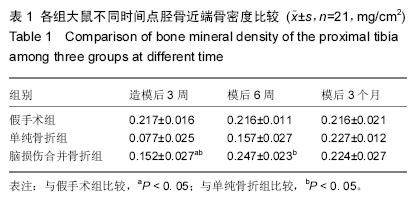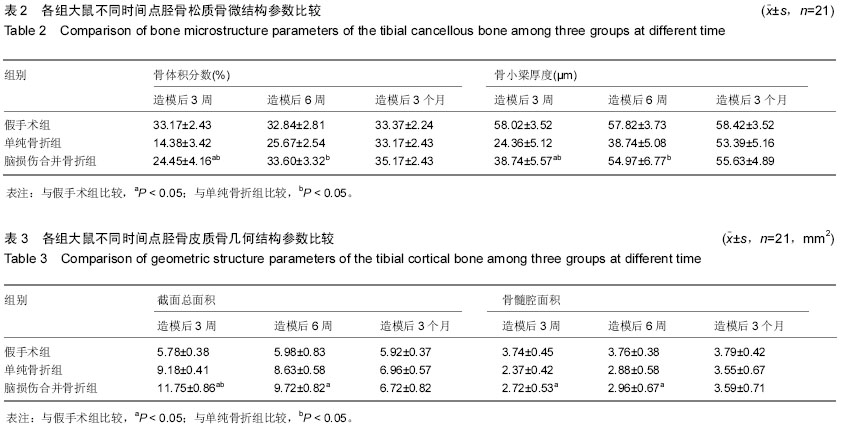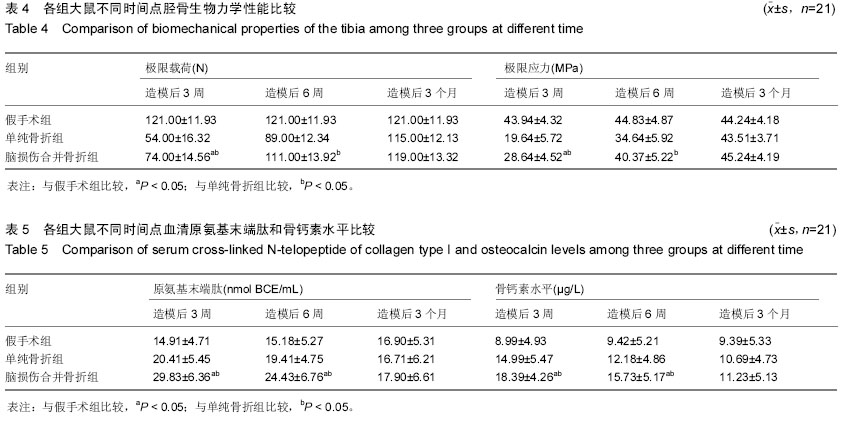| [1] 曾凡瑞,谭文甫.骨折合并脑损伤时骨折愈合加速的研究[J].社区医学杂志,2012,10(13):13-15.
[2] Marmarou A. A new model of diffuse brain injury in rats. Pathophysiology and biomechanics. J Neurosurg. 1994;80(2): 301-313.
[3] Roberts JM. Multiple injuries: management of the patient with a fractured femur and a head injury. J Bone Joint Surg. 1968; 42(3):425.
[4] Boes M, Kain M, Kakar S, et al. Osteogenic effects of traumatic brain injury on experimental fracture-healing. J Bone Joint Surg Am. 2006;88(4):738-743.
[5] Zwerina J, Redlich K, Polzer K, et al. TNF- induced structural Joint Damage is mediated by IL-1. Proc Natl Acad Sci USA. 2007;104(28):11742-11747.
[6] Bidner SM, Rubins IM, Desjardins JV, et al. Evidence for a humoral mechanism for enhanced osteogenesis after head injury. J Bone Joint Surg Am. 1990;72(8):1144-1149.
[7] Perkin SR, Skirving AP. Callus formation and the rate of healing of femoral fractures in patients with head injuries. J Bone Joint Surg. 1987;69(4):521.
[8] 沈红雷,周悦.脑损伤合并骨折愈合加速的原因分析[J].中外医学研究,2011,9(11):121-123.
[9] Dalle Carbonare L, Valenti MT, Bertoldo F, et al. Bone microarchitecture evaluated by histomorphometry. Micron. 2005;36(7/8):99-105.
[10] 刘丽君,罗湘杭,廖二元,等.男性骨特异性碱性磷酸酶、骨钙素、Ⅰ型胶原氨基末端肽与骨密度的关系[J].中国骨质疏松杂志, 2007,13(11):783-787.
[11] 赵重熙,马军,何宁,等.局部应用神经生长因子对周围神经损伤后骨折早期愈合的影响[J].中国组织工程研究,2015,19(15):2320- 2324.
[12] 杨森,王海龙,盛伟斌,等.骨折合并脊髓损伤患者血清中转化生长因子β1变化:有利于促进骨折愈合[J].中国组织工程研究, 2015, 19(2):165-169.
[13] 赵金平.大鼠脑损伤合并骨折时低氧诱导因子-1对骨折愈合的影响[J].临床和实验医学杂志,2013,12(8):572-576.
[14] 方玲娜,戴如春,盛志峰,等.去卵巢大鼠胫骨和椎骨松质骨微结构的显微CT分析[J].中国组织疏松杂志,2011,17(9):757-760.
[15] 李展春,刘祖德,戴力扬,等.MicroPET/CT评价去卵巢大鼠骨代谢变化的实验研究[J].中国骨质疏松杂志,2014,20(8):875-879.
[16] 刘巍,粱志刚,张先锋.转化生长因子β在骨质疏松骨折愈合过程中表达的实验研究[J].中国药物与临床,2013,13(12): 1562-1564.
[17] 王海龙,盛伟斌,徐韬,等.大鼠股骨骨折合并脊髓损伤模型的构建[J].中国组织工程研究,2014,18(18):2818-2823.
[18] 朱生根,苏利强,徐明.神经生长因子与被动运动对失神经大鼠骨代谢指标的影响[J].中国骨质疏松杂志,2014,20(6):606-609.
[19] 王立明,张伟,陈坤,等.神经生长因子及其受体在下颌骨骨折愈合中的表达及意义[J].实用口腔医学杂志,2011,27(4):460-464
[20] 张冉,孙宏志.神经生长因子在合并颅脑损伤的股骨干骨折修复中的意义[J].中华神经医学杂志,2010,9(12):1265-1267.
[21] 贾考田.神经生长因子对84例骨折患者愈合情况的临床观察[J].北方药学,2013,(5):90.
[22] 李东海,周安宁.周围神经损伤后局部应用神经生长因子对骨折早期愈合的影响[J].中国实用神经疾病杂志,2014,17(22):68-69.
[23] 张贵春,张永.神经生长因子对合并神经损伤胫骨骨折早期愈合的影响[J].中国组织工程研究与临床康复,2009,13(11):2057- 2061.
[24] 曹玲,杨光.增龄与骨骼肌肌细胞的退变[J].中国老年学杂志, 2014,(10):2893-2896.
[25] 李西华,赵蕾,吴燕,等.神经源性一氧化氮合酶对临床疑似Becker型肌营养不良的诊断意义[J].中国当代儿科杂志,2011,13(4): 288-291.
[26] 粟谋,徐威,蒋林彬,等.影响神经生长因子表达因素的研究进展[J].重庆医学,2014,56(6):735-737. |


